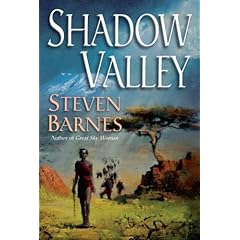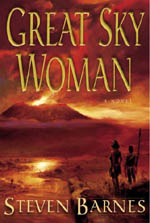The following is an approximation of a talk given in 2004 at the Smithsonian Institute by yours truly.
#####
Approximately 30,000 years ago there was a major shift in human consciousness, if one judges by cave paintings in France and South Africa.Human beings who, before, had been exquisitely aware of their environment suddenly seemed to become aware that THEY were in the environment. It was as if the ego suddenly awakened.
##
For centuries, people have theorized about what separates humanity from other animals. I've heard a lot of things, most of them have either been disproven or depend upon discounting apparently similar behaviors in other species: speech, tool-using, dreaming, year-round sexuality, all kindsa interesting stuff. I decided on my own theory, one that definitely irritated my cultural and biological anthropologist friends--although they couldn't disprove it. My distinction is this: human beings are that group of creatures that make and use fire as a tool. All human societies use fire. No animals do. So there.
##
What relationship might one draw between fire and consciousness, however? And how is it linked to storytelling? Well...
Fire was probably first observed through spontaneous combustion, volcanic activity, or lightning strikes. Humans used it, and then somehow tamed it. It was a great weapon against predators, and allowed people to control light. This was vital, because we aren't great nocturnal hunters, and many of the things that killed us were. Fire also allowed us to harden the tips of spears, making them more effective killing tools--making hunting more efficient. Fire could also be used to drive herds of animals too large to be easily hunted by puny human muscles--drive them into defiles and over cliffs. The acquisition of large amounts of high-grade protein became a reality. Fire could also be used to cook that meat, making the protein more bioavailable, leading to the expansion of cranial size in subsequent generations, increasing intelligence and leading to the development of more complex and efficient hunting strategies--an ascending spiral that lead to human beings being the most efficient predators that have ever lived.
##
But these more efficient hunting strategies lead to the need to communicate with other hunters, both ON the hunt and during preparatory periods. A successful tactic can't just be rediscovered accidentally over and over--it needs to be taught to the younger hunters. Pantomime, hand signs, and auditory symbols became even more vital to the maintenance of that flow of high-quality protein, and as societies became larger and more complex, that protein flow became more and more important. After all, nobody every referred to the chief's elite guard as "beet-eaters," did they?
##
Fire allowed another fascinating development: controlled shadows on rocks and cave walls. Rather than just being limited to shadows thrown by the sun, medicine men and women had controlled light, could plan shadow-dances (such as the Southwest Indian "Kochina Dances") to "reveal the spirits" of the young males and females. As fire extended the hours of social interaction, group communication blossomed, and with controlled shadows came the awareness that 3-dimensional forms could create 2-dimensional images: the beginnings of abstract art, and perhaps abstract thought itself. The beginnings of cave painting, anyone?
##
Symbols on cave walls and rocks and trees, more permanent than shamanic symbols drawn in dirt, created proto-written language. Complex series of pantomimed motions around the fire evolved into stories: those who kept their children's interest best communicated their messages best. To the degree that those messages enhanced survival, their children survived: THE STORYTELLER'S CHILDREN SURVIVED, and those who could not arrange their messages in such a fashion were less successful at passing on these memes.
##
Storytelling allowed us to bind information in nonlinear matrices: not just sequenced by temporal order, but accented by emotional meaning. After all, your first kiss, shared thirty years ago, is more significant than the cheese sandwich you ate yesterday. The creation of origin stories--which in all cultures connect the people directly to the Gods and Goddesses--became important to the unity of a people. I suspect that the admirable resiliency of the Jewish people is due partly to the strength of their stories. And note this: if you want my opinion of one of the core reasons black Americans have struggled so much, they may be the ONLY people in the history of the world who have been so utterly cut off from their own creation myths--they have no language, no ancient heroes, and worship a god-figure that resembles their oppressor. Scary. When you have no story, you accept whatever you are told.
##
Storytelling allowed people to carry their identity with them, to travel to other lands and communicate, through shamanic symbols, that they were the great people of the valley, or the mountain, who have traveled far and wish only peace...or demand tribute...or wish to marry their sons and daughters. Whatever. It allowed them to control their identity, which is critical to emotional and social health.
##
Each of us has the ability, and the right, and the obligation to investigate our cultural and personal myths. Our ancestors fought for uncounted thousands of years to develop the sophisticated tools ow available to us. Pray to god we won't waste them on "Baywatch."
##
But then...oops! I wrote four episodes of that noble show, didn't I...
Wednesday, February 09, 2005
Fire, Storytelling, and Human Consciousness
Posted by
Steven Barnes
at
8:04 AM
![]()
Subscribe to:
Post Comments (Atom)







No comments:
Post a Comment